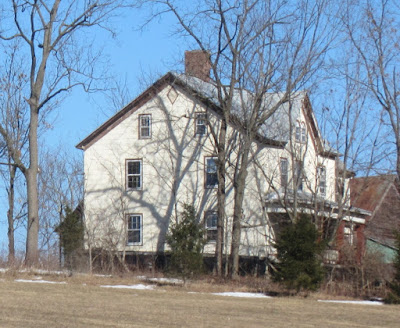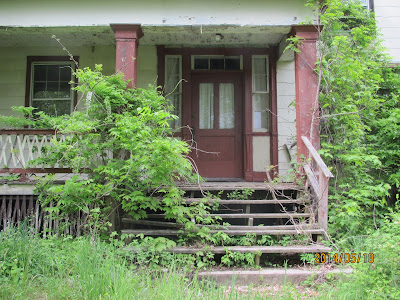In short, the Campbell farm was located slightly farther south on Route 208 than previously proposed. Its location was most likely right on top of the current major intersection of 17K and 208. At that date, Route 17K did not exist. The ancestral Milliken lands (on which Captain Peter Milliken's historic home still stands...see prior blog) sat to the north of these lands on Coleman Road.
 |
| Outline of Campbell Farm described in 1793 Deed in Montgomery, Orange, NY. |
Background
The location of the Campbell farm described in a 1793 deed to Thomas Barkley was previously identified as stradling Route 208 at its intersection with Coleman Rd. The deed gives a detailed survey of the property including the identification of neighbors. A sale of property from Barkley to Bowne in 1826 (Liber FF397) seemed to match up with the half of this property on the West of 208.
Recently that location has been called into question. The property north of Coleman Rd contains the home of Captain Peter Milliken of the war of 1812, who was the son of Captain James Milliken who was killed at the Revolutionary Battle of Fort Montgomery. He was the son of Alexander Milliken who is mentioned in the 1793 Campbell deed as being on their northern border. Had I misplaced the northern border of the Campbell farm?
My prior analysis involved plotting the shape of the farm from the survey data in the deed, then positioning it on the 1862 farm map based on survey points that fell on Route 208 and farm lines on the 1862 map and on current satellite images. The survey was rotated to match the 'north' on the 1862 map and stretched to match road curvatures and geographical features (stone walls/edges of fields/1862 borders). I was particularly struck by the notch in the northwest corner of the 1862 Peter Eager property which seemed to match the notch in the 1793 deed (called "Winan's corner"). In addition, the curvature in Route 208 where the 'old road' still exists seemed to match the curvature in the southern part of the Campbell/Barkley farm of 1793. Those features led to my location of the farm as shown in the prior blog.
Reanalysis
The major factors in repositioning the location of the farm were 1) identification of the 1719 Kennedy Patent in which the Campbell farm was located and 2) the placement of the 1793 survey on a Global Information Systems map rather than the inaccurate 1862 map allowing better matching of Route 208 curvatures with those in the 1793 survey.
The Kennedy Patent is an almost triangular 2000-acre parcel granted to Archibald Kennedy in 1719. The 1719 grants are historical and appear in many documents and maps.
 |
| 1719 Patents shown on map of 1829. Archibald Kennedy Patent of 2000 acres shown with blue dashed lines. |
In 1740, Benjamin Haynes Sr. acquired a parcel in the Kennedy patent that stretched from its northern to southern boundaries. He deeded that property to his son, David, in 1743 (Ulster Liber FF154 [113]). The deed gives a survey not only of the property in question, but also of the 2000-acre Kennedy patent in which both the Campbell farm and the Haynes farm were located. The deed goes on to describe the location of the farm of Haynes's son, Benjamin Jr., which is further west, but also in the Kennedy patent and sharing its northern boundary with Kennedy boundary.
The farm of Benjamin Haynes (Haines) Jr. eventually came into the hands of Thomas Wait who is shown on the 1862 farm map. A survey of this land is contained in the deed of Nathan Haines (grandson) to James Kerr in 1826 (Liber CC195 [133]) The description of that sale has Johnston Young to the east, Peter Milliken to the north, Samuel J. Scott to the east, and the Newburgh Turnpike (17K) on the south. The interesting part about this sale was that Nathan needed to make a payment to James and John Barkley (sons of Thomas Barkley to whom the Campbells had sold their farm) and their wives. In the small world of Montgomery, the Barkley brothers had married the Haines sisters, Ann and Martha.
The surveys of the Haines' farms with respect to 17K (north/south positioning) and correlation with the 1862 map (east/west positioning) give us a good indication of the boundaries of the Kennedy patent. Combined with current existing parcel boundaries on the Orange County GIS map, the location of the Kennedy patent was determined.
 |
| Parcels in Kennedy Patent plotted on Orange County GIS map. See description below. See High Resolution Version of map here. |
Note that the Kennedy Patent border is south of Coleman Road. The Campbell farm was in the Kennedy Patent, so the Campbell farm did not include land where the Peter Milliken home stands (as previously proposed). Indeed, this supports the statements that the ancestral Milliken lands were on Route 208 in the James Alexander Patent which borders the Kennedy Patent to the north. This location is stated as early as 1735 in the Records of the Road Commissioners of Ulster County. But did the Millikens also own land to the south of that in the Kennedy Patent? If they did, it would force the location of the Campbell farm even further south on Route 208.
Generally the historic 1719 patent lines were reflected in later parcel boundaries. However, in the 1862 map, Peter Eager (inheritor of Milliken lands) has land that juts below the Alexander/Kennedy Patent line near Route 208. It is now believed that this small chunk in the Kennedy patent was also ancestral Milliken lands. First, the 1793 Campbell survey fits nicely with that chunk as its northern border (see zoomed image) and Milliken land was known to border on its north. Secondly, it makes the Campbell farm coincide nicely with the 1862 farm of Robert Young. Exactly how Young acquired the land from Thomas Barkley is not known, however Robert Young's father, Johnston Young, was married to a daughter of Thomas Barkley, so it may have come as some sort of inheritance. Thirdly, the survey of the Campbells did not mention the colocation of any of its borders with those of the Kennedy Patent. This location agrees with this.
One interesting note is that the Newburgh-Cochecton Turnpike (17K) had not been built in 1793 (the road running east-west through the parcels above). The main east-west road, known as the Wallkill Road, coincided roughly with the current Bracken Road to the south (bottom of the above map). When the new road was built in 1800, the historic Campbell farm was further split. Today it is a busy intersection. This location is much more developed than the one previously thought to be the site of the farm.
Well...that is how research goes. Sometimes you get it wrong.
Full write-up on 1793 Campbell-Barkley Deed (written in 2012)










